COVID19: Reimaging where and how we’ll get work done
14 min read

14 min read

Starting from March 2020 we all witnessed (and, quite frankly, we are still witnessing) a monumental shift from the office-first mindset to remote and hybrid work.
Remote work isn’t an invention we owe to the Covid-19 pandemic. People have known remote work for years now but it didn’t quite get the spotlight until companies had no choice but to send their workers home.
There are many people who have been working remotely way before 2020, myself included.
To paint a picture made up from numbers, here’s a report from Findstack, showing that 58.6% of the total US workforce are remote workers.

Although not a new concept, remote and hybrid work are hot topics right now.
Companies are grappling to make plans for their workforce to return to the offices, pushing those deadlines out, moving to different spaces, and canceling leases.
This is why we have decided to outline some of the most common phrases we all probably heard over the course of the last 18 months with the idea of explaining that there is no unique approach to this global crisis and things inevitably have to change. This change, however, impacts workers’ lives and there is hardly one solution that fits all.
The following phrases are generalizations and as such, they shouldn’t be taken lightly. Assuming everyone will react in the same manner to something is wrong in so many ways. This is our cue and we shall without further ado introduce to you the said phrases.
This one should be a no-brainer. Has anything ever worked for absolutely everyone?
Not everyone is charmed by remote work and that shouldn’t come off as a surprise. People have different personalities, living situations, and preferences. Bottom line is, people also have different jobs. How do you pave the road, extract wisdom teeth or perform surgeries from home?
Remote work is being celebrated for many reasons, one of them being that it democratizes work by offering a wider talent pool that is not limited by geographical position. Still, it has its shortcomings and it is not equal for all since it is not available to all.
Assuming it is on the table, there’s still a long list of boxes that ought to be checked in order for remote work to fit into your world.
Not everyone will be able to work from home, even if it’s just a couple of days a week. It can be due to a spotty internet connection, loud family members, demands that come along with parenting or caring, pets that won’t leave you alone, or uncomfortable or unroomy working space. Putting external factors aside, there will be employees who don’t feel comfortable working on their own and spending a good chunk of their day left to themselves.
In the hybrid work scenario, this is also a question of personality. Employees who appreciate maintaining a fixed routine might struggle to switch their work settings every few days. When you do the hybrid model of work, you are constantly moving between two worlds and for some people, it will feel as if they don’t get a chance to adjust to either.
PwC conducted a survey that included 133 executives and 1,200 office workers and the results have shown that there is a generally positive sentiment toward working from home. In fact, they conducted this survey in July 2020 and then repeated it in December that same year. There was a significant shift in a positive attitude towards remote work for both employees and employers. As much as 83% of surveyed employers found the shift to working remotely successful, which is a 10% increase compared to their survey conducted 6 months prior.
In addition to that, this survey uncovered a general consensus over the fact that the office is here to stay but it may play a different role than it once did. Less than one in five executives said that they would like to return to the pre-pandemic, office workplace. The rest of the respondents were all trying to figure out how to extend remote work options. Still, only 13% said they were ready to leave the office behind, while the rest of them think of it as an important piece of the puzzle that helps bring the team members together and builds stronger relationships.
This brings us to the hybrid workplace, which seems to have gained a lot of momentum over the past few months. Based on the survey results, it’s difficult to reach an agreement on the optimal number of workdays you spend at home versus in the office. Over 55% of employee respondents said that they would like to be remote at least three days a week once the pandemic is behind us. However, close to 70% of surveyed employers said that a typical employee ought to spend at least three days a week in the office in order to maintain a distinct company culture.

There are a number of reports, papers, and surveys that saying this shift from the office to a WFH environment brought a treat for everyone in the form of an increase in productivity. In fact, the two surveys we already referenced, conducted by PwC, concur with the above.
In December, 32% of employees said they feel more productive working remotely versus 28% that said so in July 2020. With the employers, the results were awfully similar, as 52% of them said in the survey conducted in December the average employee productivity has increased while working remotely, versus 44% of them saying so in July 2020.
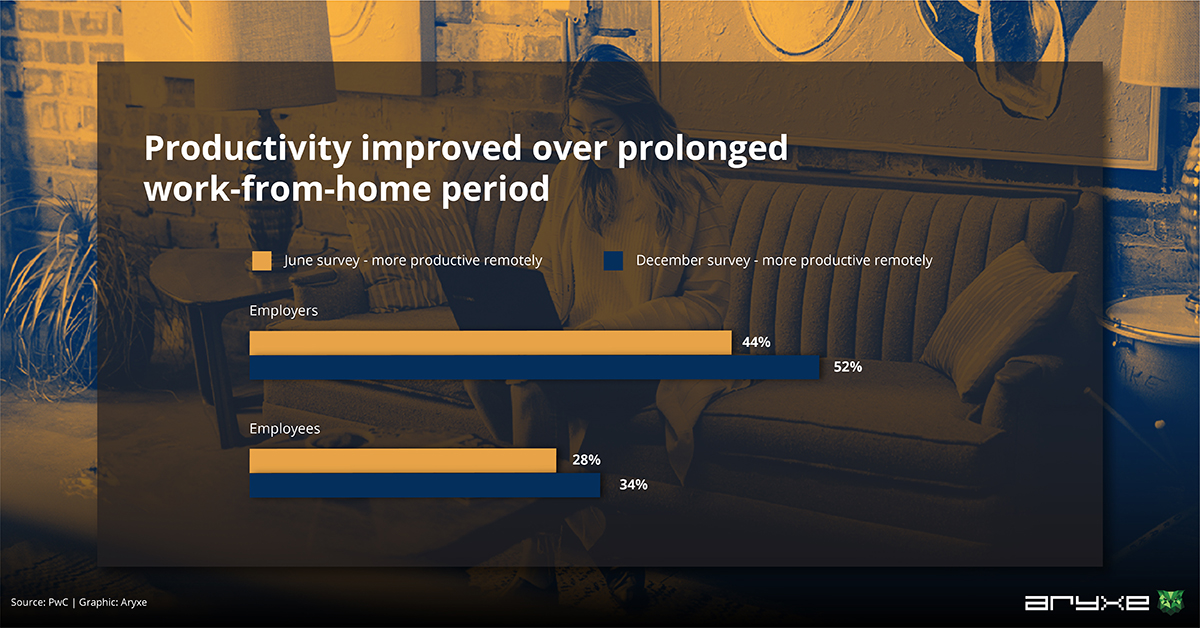
The results are pretty encouraging but let’s not get ahead of ourselves here. Those who are not convinced by these results attribute the increase in productivity to either panic working or over-working.
Panic productivity or fleeting crisis phenomenon is one of the explanations WFH skeptics use to try and explain why there is an increase in productivity. Early on, in the first six months of 2020, people were scared of losing their jobs. Companies were in panic mode, and so were their employees. There were layoffs, pay cuts, and furloughs all around. Therefore, those who were still working, only now from their homes, worked twice as hard in order to keep their jobs, hence the spike in productivity and an overall feeling of being more productive when working from home.
Another explanation is that working from home more times than not means overworking yourself. The ability to leave the work behind once you leave the office is a luxury not many WFH workers have. Reports show that working from home means putting in more hours, and in turn, being more productive thanks to more time you are spending at work than what you should be.
Therefore, surveys conducted in conditions where people are still concerned about the possibility of losing their job and panic working or overworking themselves to ensure they don’t may be something we want to hold on to.
The hybrid model of work seems to be the front runner among both employees and employers. The reason for that is simple. Hybrid work stands for more flexibility. Hybrid work tends to include more freedom around the place you work from and the schedule, too.
People want a hybrid workplace because it grants more autonomy to employees. In a traditional, office-first setup, you are expected to fit your life around the hours you need to log at the office. You plan your dentist visit to take place after work, shopping for groceries on weekends, taking your SO out for lunch on days off and this list can go on forever. In a hybrid work model, you have the opportunity to fit work around the rest of your life. It works better just knowing you have the option to do your work later if something unexpected comes up.
Hybrid work offers you structure and sociability while allowing you to maintain independence and flexibility.
The world we live in doesn’t require a physical presence in order for us to talk and exchange information. Still, in the world of work, there are situations when physical presence is preferred. So, a hybrid work model allows just that. We can fix in-office meetings on certain days, team buildings, project kick-offs to take place on-site, and then do everything else remotely.
Ideally, remote working days should be organized in a way that video sessions are down to a minimum and you take up as much time as possible for tasks that demand focus and concentration. There are tasks that sometimes take a few hours of your day at the office, due to having many people around you while it might take you an hour or two to complete them at home.
The hybrid model is enticing because it is the middle ground and it reconciles the two extremes.
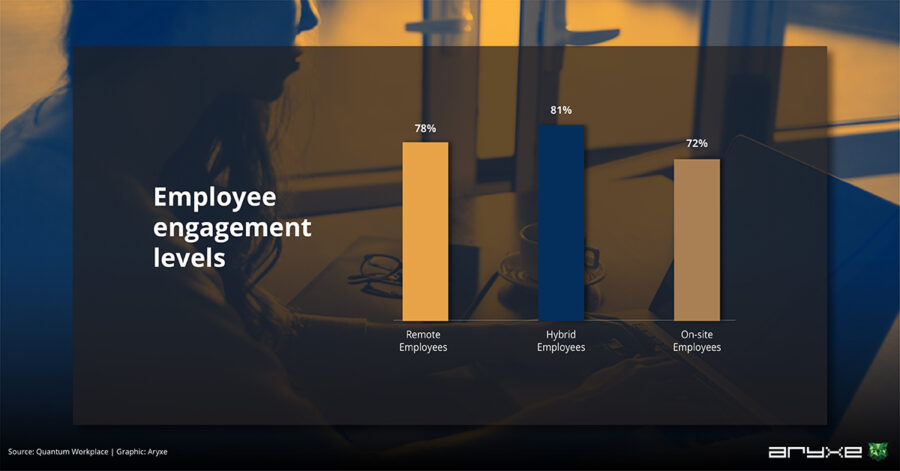
We can’t simply skip over the workers who aren’t fans of any other work model than the 100% office-based or 100% remote. Hybrid working patterns can’t suit everyone.
The shift to remote work is seen as both the equalizer and the divide that is widening the socioeconomic and racial inequality.
Making a hybrid workplace equal is a tough challenge that not many companies will be able to overcome. To be successful in the corporate world, you can’t only be good because that isn’t good enough. So, you need to network with the right people, make yourself known and seen. Therefore, employees that spend more time at the office versus those that have more home working days will inadvertently have a disproportionate share of power. They will be the office regulars and as such carry the edge over home workers.
If inadequately planned, hybrid work might have neither the interaction of face-to-face work nor the egalitarianism that fully remote workforces can aspire to.
The first half of 2021 showed us how fully remote work lost its charm while hybrid work maintained stable levels but its shortcomings may result in a different picture, so we shall wait and see.
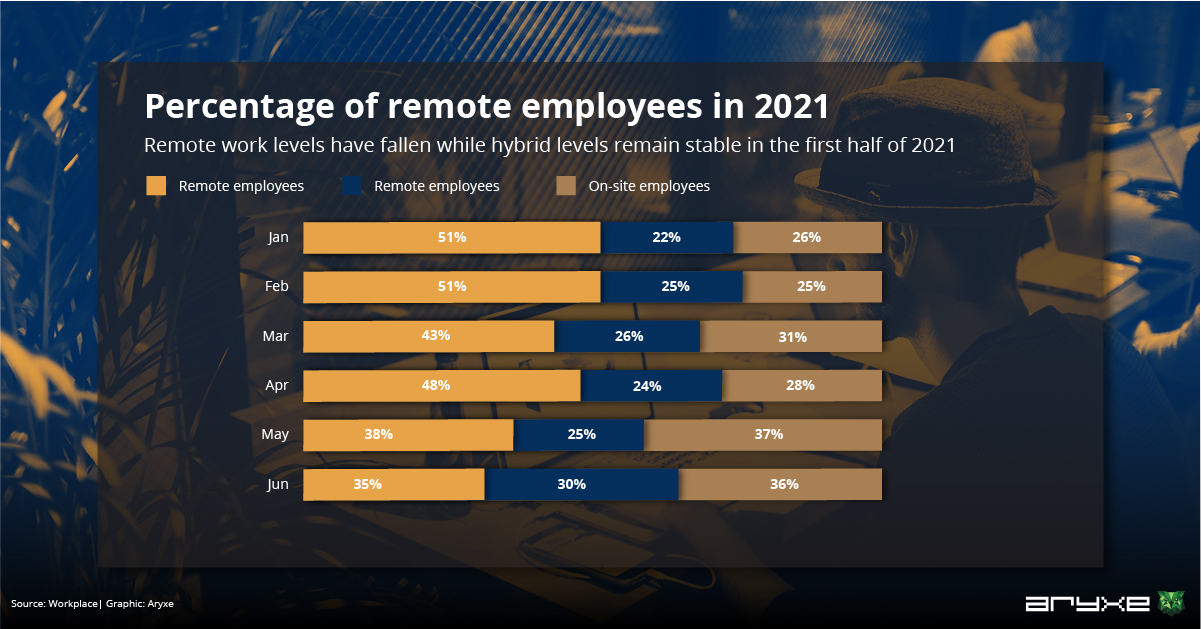
There’s not a lot we can say for sure during this Covid-19 pandemic but with a distinct level of certainty, we dare say the office is far from dead. Companies are keeping their ears to the ground and taking up the opportunity to be creative with the workspace over the next few years.
Visits to the office are now seen as experiences that enhance company culture and strengthen the team. The focus will probably be on office decor, an increase in collaborative hubs, and overall making more effort to build a comfortable workplace. We assume that some will bring private offices back and say the long-awaited goodbye to cubicles and open floor plans. The past 18 months helped companies realize that some employees need or prefer having a place to go to work, alongside a place where they can build relationships and socialize.
Another change that is likely to be seen in the office demand model will be driven by the need for social distancing. Office tenants will require more square meters per employee than what was required before the coronavirus outbreak.
The number of workers who will be on-site each day will dictate space needs. This means that space will need to allow them to be productive and meet all health safety concerns at all times. A hybrid work model and flexible use of office space will result in fluctuating space needs, making planning more difficult but surely not impossible.
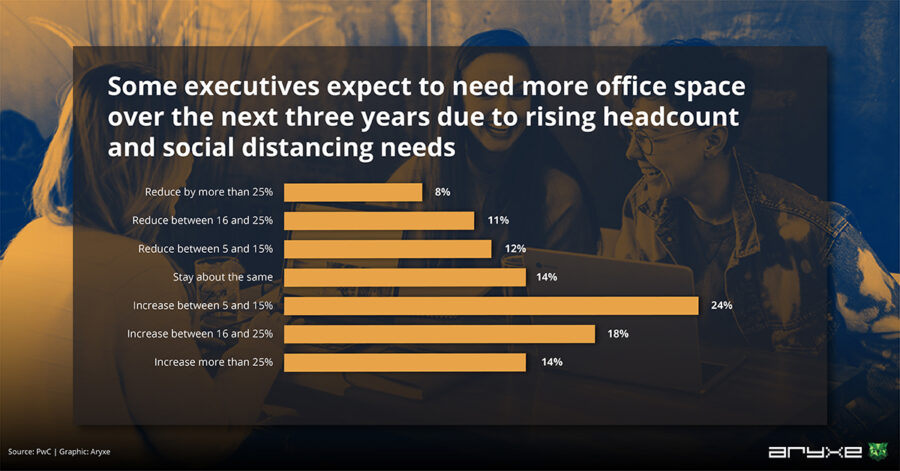
Remote work revolution wasn’t triggered by the coronavirus pandemic but it definitely was sped up by it. The report published by Glassdoor shows a steady, and quite hefty, increase in the monthly share of remote job searches. The question is whether this trend will stick around once the pandemic is behind us.
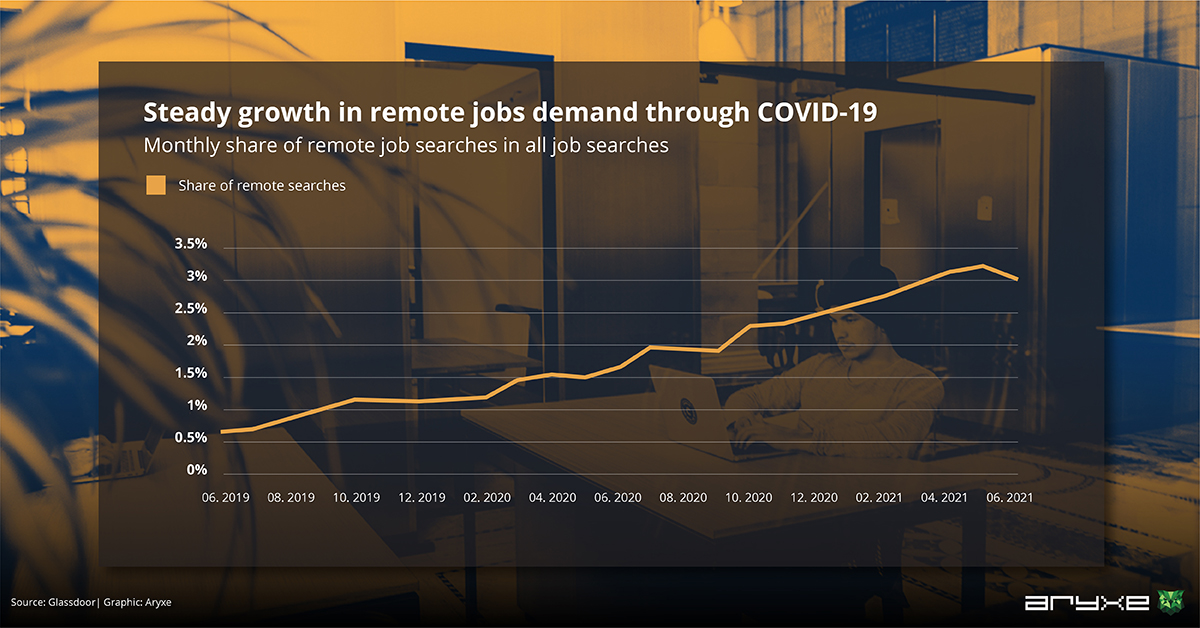
For a lot of companies, remote work turned out to be successful. As a result, many are heading toward a complete transition into remote work or, more likely, a hybrid workplace.
Being flexible is the key because people have now had a chance to try both options and can decide that you bounding them to an office or their living room is not going to happen.
One thing no employer should take lightly is the fact that people won’t be afraid to quit any longer, having seen the other side. Taking this as a great segway to the very last phrase we’ll cover today.
Yes, the pandemic led many into the fear of losing their jobs, and rightfully so. Industries were suddenly hit with lockdowns and safety measures that they couldn’t keep up with. Still, we shouldn’t assume people are desperate to keep their jobs at all costs now. If they were, what could possibly explain the widespread labor shortages and the so-called “Great Resignation”?
It’s quite natural to see an increasing number of notices and resignations, no matter the industry. The pandemic has changed peoples’ mindsets in a way. They simply value their time now more than ever.
People are leaving their jobs in search of more money, more flexibility, and more happiness. All over the globe, many are reconsidering what work truly means to them. Does what I do matter to someone? Am I valued for my work? How am I spending my time?
All these are valid questions and have lead to a dramatic increase in resignations. According to the Labor Department in the United States, in April 2021 alone a record 4 million people made the decision to quit their jobs.
A survey conducted by Microsoft, including more than 30,000 global workers, has shown that 41% of workers were considering quitting or changing professions by the end of 2021.
For some workers, the coronavirus pandemic led to a shift in priorities. Being surrounded by bad news, deaths and an overall state of panic was sort of a wake-up call that encouraged them to pursue a “dream job” and give more value to how and where they spend their time.
Employers who are not addressing their workers’ concerns promptly and seriously, will inevitably suffer from the loss of a valuable workforce.
If people feel undervalued and unheard, they are likely not to put up with it anymore.
Retail and service sectors have been under great pressure due to the mass exodus on all levels. Major retailers are scrambling to fill open positions and having major difficulties finding enough staff. McDonald’s and Amazon are offering hiring bonuses ranging from $200 to $1,000 and they are still having trouble filling empty spots. This is a great example showing that while financial incentives are a start, the main priority isn’t more money. Jobs that may pay less are interesting if they offer more benefits, flexibility in regards to the place of work and schedule, and better company culture.
If you ask people whether they would be willing to take a pay cut and work for a company that aligns with their values and you’ll see a slew of positive answers.
We think so. And, we hope so.
The Great Resignation might have a long-term impact on workplace culture and the way companies invest in their employees.
This change was unraveling even before the pandemic but the year 2020 shifted the existing feelings and inclinations into overdrive. Companies will need to put more emphasis on flexibility, invest in health insurance, and up their caring game when it comes to employees’ needs.
Bottom line is, companies that don’t invest in their people will end up falling behind.
Any reuse, transmission, republication, duplication, or distribution of this article and graphics, without the express written permission of Aryxe is not allowed. If you wish to reuse, transmit, republish, duplicate or distribute this article, cite passages, or use in full, including but not limited to proprietary text and graphics, please request written permission.